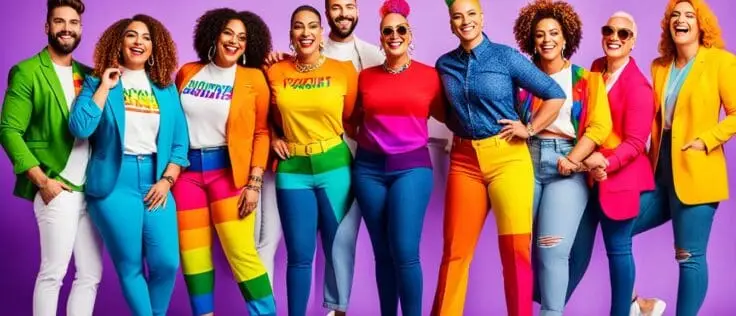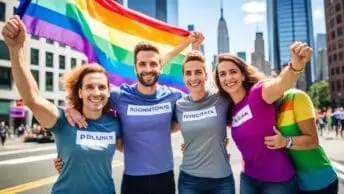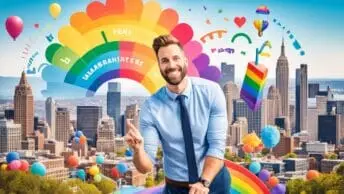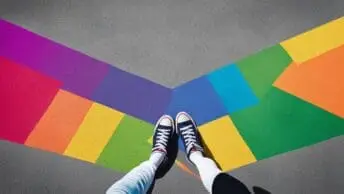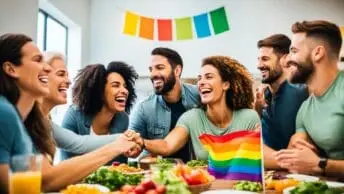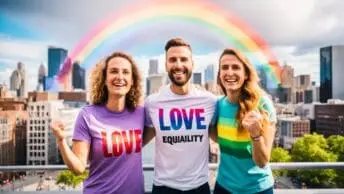Ever wondered why some LGBTQ+ figures aren’t well-known despite big achievements? During LGBTQ+ History Month, we dive into the lives of Queer Leaders and Organisations. Their bravery and activism have changed society.
This month is not just about looking back. It also highlights ongoing work by UK LGBTQ+ activists. Consider John Radclyffe Hall’s battles for their literary work. And today’s heroes like Dr Rita Nketiah and Radam Ridwan, who fight for rights and education. They deserve our thanks.
It’s crucial to also celebrate the role models in our own lives. Friends, family, co-workers, and local leaders have deeply touched us. Their stories of overcoming hardships shine a light on the LGBTQ+ community’s efforts.
The work of both past and present figures motivates us. They encourage future generations to build a world where everyone can be themselves. This means living openly and without fear.
Introduction to LGBTQ+ Role Models
Spotlighting LGBTQ+ role models highlights the rich tapestry of the community’s history. It celebrates its strides towards inclusivity and equality. Their stories show courage, resilience, and a commitment to LGBTQ+ advocacy and queer visibility. They offer deep insights into the LGBTQ+ societal impact. These figures are crucial in shaping future advancements.
Stonewall, a key LGBTQ+ charity in the UK, started in 1989 in London. It has been pivotal in fighting for LGBTQ+ rights for over thirty years. Its work in marriage, parenting, and education has been transformative. By working with Welsh employers and schools, Stonewall boosts queer visibility.
Diverse LGBTQ+ history role models reflect our complex society. In Wales, “Glitter Cymru” helps LGBTQ+ and BAME people. It stands against discrimination and stereotypes, promoting positive change.
Creating safe spaces for sharing experiences is essential for acceptance. Role models and allies teach us about kindness, love, and resilience. With over 750 groups in Stonewall’s Diversity Champions Programme, these efforts have a big impact.
Forces for change include Stephanie Morgan and Dr. Elly Barnes MBE. Morgan was an ‘out’ gay police officer. Dr. Barnes has made education more LGBTQ+ friendly since 2005. Their efforts continue to inspire and shape LGBTQ+ advocacy’s future.
Historical LGBTQ+ Figures
History is full of LGBTQ+ heroes who broke social norms to lead the way for others. Alan Turing, a key codebreaker during World War Two, suffered due to his sexuality in the 1950s. His pardon in 2013 and the “Turing law” highlight the impact that LGBTQ+ figures have had.
James Baldwin shed light on race, sexuality, and identity in his 1953 book. Christine Jorgensen challenged gender norms with her transition in the 1950s, opening conversations on transgender topics.
Bayard Rustin worked with Martin Luther King, Jr. before focusing on LGBTQ+ issues in the 1980s. Barbara Gittings joined the Daughters of Bilitis in 1958, playing a key role in LGBTQ+ advocacy.
Marsha P. Johnson and Sylvia Rivera were pivotal during the 1969 Stonewall riots. They also founded the Street Transvestite Action Revolutionaries, promoting inclusion in the fight for equal rights.
The gay pride flag, created by Gilbert Baker in 1978, became a symbol of hope for LGBTQ+ communities. Larry Kramer fought for LGBTQ+ health rights, founding the Gay Men’s Health Crisis in 1981 and Act Up in the 1980s, especially during the HIV/AIDS crisis.
These outstanding individuals have built a strong legacy for LGBTQ+ rights. Through literature, activism, and advocacy, they’ve inspired many, showing the enduring influence of LGBTQ+ historical figures.
Modern LGBTQ+ Role Models in the UK
In recent years, the UK has seen amazing LGBTQ+ people leading the way to inclusivity. Travis Alabanza is a standout, using art to deal with transphobia. Their work not only promotes queer visibility but also starts IMPORTANT discussions on inclusion.

The sports world benefits from LGBTQ+ athletes like footballer Josh Cavallo. He courageously challenges homophobia in sports. His efforts are paving the way for a more inclusive atmosphere in this arena.
Stonewall, founded in 1989, is key in advancing LGBTQ+ rights in the UK. They partner with businesses and schools to ensure everyone can be their true selves. Their work highlights the value of LGBTQ+ leaders in improving queer visibility.
In Wales, a guide introduces LGBTQ+ professionals as role models. It includes scientists, dietitians, and artists. Their stories foster acceptance and underline the need for diverse LGBTQ+ representation.
Groups like Glitter Cymru support LGBTQ+ and BAME individuals, especially during difficult times such as the pandemic. Their efforts show how vital community and solidarity are in overcoming challenges.
The University of Glasgow is committed to inclusivity, with special coordinators for LGBTQ+ students. These steps reflect the wider journey toward LGBTQ+ equality in the UK. This journey includes significant changes like repealing Section 28 and introducing the Equality Act (2010).
Today, UK’s LGBTQ+ role models are vital in advocating for a better society. They impact various sectors, showing the importance of diverse queer representation.
Unsung LGBTQ+ Heroes
Many lesser-known LGBTQ+ activists have played a big role in the rights movement. Shay Patten-Walker and Selly Thiam are just a few. They tirelessly fight for local causes and rights.
The first UK pride march in 1972 drew over 2,000 people. It was a milestone in the movement. Ted Brown was one of the key organisers.
Barbara Gittings made huge strides by founding the Daughters of Bilitis. She also helped remove homosexuality from the list of mental illnesses recognised by the American Psychiatric Association.
Lady Phyll,co-founder of UK Black Pride, promotes unity among Black LGBTQ+ folks. Grassroots movements like these push for equality and supportive community spaces.
Oluwatoyin Salau and Mark Ashton are great examples of bravery in the activist community. They showed true dedication to the cause.
Moonlight Experiences, started by queer people, supports QTIBPOC individuals in travel. They use their profits to help the community and keep the legacy of these heroes alive.
It is important to celebrate these lesser-known activists. They teach us the value of every voice in the fight for equal rights and representation.
LGBTQ+ Activists Making a Difference
Modern LGBTQ+ champions like Jay Stewart and Chay Brown have pushed for big changes. They fight for equality. Along with Lady Phyll, they show the key role of activism. Jay Stewart, co-founder of Gendered Intelligence, educates on transgender issues. Chay Brown raises awareness for queer people of colour, reflecting vital intersectional activism.
Lady Phyll works hard through UK Black Pride for LGBTQ+ people of colour’s rights. Their actions are central to LGBTQ+ advocacy. They ensure diverse voices are respected and heard.
These activists’ work impacts campaigns and organisations, boosting LGBTQ+ rights. They address crucial social challenges. Their actions move us towards a more accepting world. The effect of their dedication is widespread.
Sylvia Rivera and Marsha P. Johnson stood up for homeless transgender youth. They started S.T.A.R. Their bravery motivates activists today.
Josephine Baker and Karl Heinrich Ulrichs also set high standards. Baker fought against segregation while Ulrichs kick-started the gay rights movement. Modern activists continue this outstanding work. They strive to spread LGBTQ+ advocacy in all aspects of life.
Influential LGBTQ+ Artists
Queer artists shape our culture, highlighting important LGBTQ+ issues in the arts. Chris Berntsen’s photos capture the queer community’s essence. His work celebrates LGBTQ+ diversity, showing its beauty in art.

Michaela Jaé Rodriguez, a trans actress from “Pose,” was the first trans woman up for an Emmy. Her nomination is a big step for LGBTQ+ visibility in media.
Amrou Al-Kadhi and Billy Porter explore identity through performance and writing. Al-Kadhi, a non-binary drag queen and writer, talks about finding themselves. Porter, winning an Emmy, uses his talent to teach and motivate.
Rina Sawayama, a pansexual singer-songwriter, pushes for more LGBTQ+ voices in music and movies. Her advocacy and unique view add richness to culture.
Queer artists work in many ways, enriching the LGBTQ+ story. Through arts like photography, acting, and music, they fight norms and inspire many. Their work ensures LGBTQ+ voices remain vivid and influential in art.
LGBTQ+ Role Models in Media and Entertainment
The growth of LGBTQ+ representation in media brings new heroes to both spotlight and background. Figures like Billy Porter and Michaela Jaé Rodriguez shine in awards and use their influence to support queer stories. Queer entertainers make LGBTQ+ lives more visible. They add truth to LGBTQ+ on-screen diversity.
In 2019, Ofcom found that very young kids watched about 12.7 hours of TV every week. Older kids watched even more, at 46.1 hours. For them, seeing positive LGBTQ+ characters is key. Shows like “Heartstopper” and “Schitt’s Creek” win hearts with real and kind LGBTQ+ stories. They avoid clichés.
Programs like “The Owl House” on Disney Channel bring fresh perspectives with a bisexual lead and a non-binary friend. GLAAD’s reports, like “Where We Are on TV”, show how far we’ve come and what’s left to do. It’s a push for better, more varied characters on screen.
Groups like Action for Children push for good LGBTQ+ visibility. With stars like Dr. Ranj backing them, they fight for media that mirrors young lives positively.
Even with strides forward, clichés and shallow roles still exist. It’s essential to show LGBTQ+ people as full and complex beings. As media evolves, LGBTQ+ on-screen diversity must keep up. That way, every young person can feel seen and affirmed.
Politicians and Lawmakers Advocating for LGBTQ+ Rights
Leaders who support LGBTQ+ rights have made big strides in laws and inclusivity. People like Harvey Milk started the push for queer politicians. They showed how important it is to have LGBTQ+ voices in government. Now, there’s more support from allies and LGBTQ+ officials for full equality.
The House of Representatives Equality Caucus now has 10 LGBTQ+ members, a historic high. Even with over 350 anti-LGBTQ+ bills in the US, these leaders stand against discrimination. They work for positive change. In places like Vermont and California, openly LGBTQ+ candidates have won elections, boosting the community’s voice in politics.
Politicians like Andrea Jenkins have made history. Jenkins is the first openly transgender African-American woman in a high office. She now leads the Minneapolis City Council, showing how individual commitment to LGBTQ+ rights can make a difference. Jenkins inspires many by pushing for progress within the system.
Changes in top roles of LGBTQ+ organizations also show the impact of these leaders. For example, Joe Hollendoner increased funds for the Los Angeles LGBT Center. Maria Sjodin helped OutRight International aid LGBTQ+ groups globally. They’ve helped especially in places facing crisis, like Ukraine.
These leaders do more than challenge the status quo. They set new standards for equality. Their battle against prejudice and for the rights of their communities is tireless. They continue to advocate for fairness and inclusivity in every step.
Upcoming LGBTQ+ Role Models to Watch
As the LGBTQ+ community grows, new role models are appearing. They bring enthusiasm and fresh perspectives. This signals a new era of queer influencers who will motivate many.
Radam Ridwan (they/them) is making waves with their dedication to visibility. They work in social media and storytelling. This makes them a beacon for non-binary people.
Nakhane (they/them) is also an inspiring figure. They are a singer, songwriter, actor, and novelist. They use their talents to challenge norms and enhance queer visibility worldwide.
These new influencers are making important strides. They aim to make spaces more inclusive for all. Their work promises an exciting future for the LGBTQ+ community.
Conclusion
The celebration of LGBTQ+ role models shows their big impact on society and the queer community. They bring to light the importance of such figures throughout history and today. Their stories boost community strength and inspire others.
From activists to artists, these role models lead young people towards good choices. They help build up their confidence and make them feel valued. It’s clear that role models play a big part in guiding the youth.
Having positive role models helps young people aim for better. Research in the Journal of Educational Psychology shows positive encouragement from teachers boosts student success. Kids with strong role models tend to do better in school and stay out of trouble.
But it’s not just about education or feeling good about yourself. Role models also show the importance of looking after oneself. They encourage things like staying active and staying mindful. This helps everyone make healthier choices in life.
By stepping up for LGBTQ+ rights, these role models push for equality. The community’s progress depends on recognising and supporting these leaders. They work hard to build a welcoming world for everyone.
